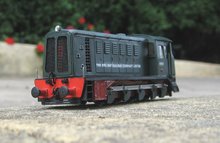
The starting point - Here's the two Bullant Major mechanisms built to Hollywood Foundry's usual quality and precision. Like the PVH chassis, they have lateral motion on the two centre axles to assist on tighter curves. Beyond this specification, these two are a bit special - they employ wheels made by SEM for WD Models, quartered on the Hollywood Foundry axles, the push-fit wheels easing this phase of construction. The wheels are slightly underscale at 39" (as against the prototypes' 43"), the 4" difference (approx. 1.2mm in HO scale) is considered an acceptable compromise for available wheels that will fit the 2mm Bullant axles. The motors chosen are the most powerful that will readily fit into the tank/bunker sections. I requested Hollywood to offset each motor to ensure they fit within the tanks/bunker and allow room for the leading/trailing bogie swing as per the picture below where the two unit's are roughly located on a scaled copy of Tony Parnell's excellent side elevation showing how the 12 Class will be powered:

(Drawing from T.Parnell in L.Rae "The Emu Bay Railway")
Next task is to define and build the framing for the two units, therein providing a platform for all the work that will occur on each unit, then fit the pickups (usually fitted by Hollywood however this wheelbase is below the minimum)











 I have fitted the LH cylinder casing and commenced reproducing the Walschaerts valve gear of the prototype recently, a picture of the incomplete installment is above. The slide valves are from Mainly Trains, the driving rod is cut down rail, and the "Walschaerts" (parenthesis as it is a close approximation rather than a scale copy) is a heavily modified set from a 4mm Alan Gibson etch for a Southern Railway (UK) U/U1 class. While the U/U1 was a very different locomotive, I chose it as the basis for the EBR 12 Class as the Walschaerts configuration was visually quite similar, and the etch readily available.
I have fitted the LH cylinder casing and commenced reproducing the Walschaerts valve gear of the prototype recently, a picture of the incomplete installment is above. The slide valves are from Mainly Trains, the driving rod is cut down rail, and the "Walschaerts" (parenthesis as it is a close approximation rather than a scale copy) is a heavily modified set from a 4mm Alan Gibson etch for a Southern Railway (UK) U/U1 class. While the U/U1 was a very different locomotive, I chose it as the basis for the EBR 12 Class as the Walschaerts configuration was visually quite similar, and the etch readily available.




































